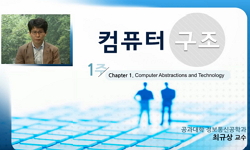






| 1. |  |
Chapter 1. Computer Avstractions and Technology | 1.. Introduction 2. Eight Great Ideas in Computer Architecture 3. Below Your Programe |  |
 |
Chapter 1. Computer Avstractions and Technology | 1. Under the Cover 2. Technologies for Building Processors and Memory 3. Performance |  |
|
| 2. |  |
Chapter 1. Computer Avstractions and Technology | 1. Performance |  |
 |
Chapter 1. Computer Avstractions and Technology | 1. The Power Wall 2. The Sea Change: The Switch to Multiprocessors 3. Concluding Remarks 4. Fallacies and Pitfalls |  |
|
| 3. |  |
Chapter 2. Instructions: Language of the Computer | 1. Introduction 2. Operations of the Computer Hardware 3. Operands of the Computer Hardware |  |
 |
Chapter 2. Instructions: Language of the Computer | 1. Signed and Unsigned Numbers 2. Representing Instructions in the Computer 3. Logical Operations 4. Instructions for Making Decisions |  |
|
| 4. |  |
Chapter 2. Instructions: Language of the Computer | 1. Supporting Procedures in Computer Hardware 2. Communicating with People |  |
 |
Chapter 2. Instructions: Language of the Computer | 1. MIPS Addressing for 32-Bit Immediates and Addresses 2. Parallelism and Instructions: Synchronization 3. Translating and Starting a Program |  |
|
| 5. |  |
Chapter 2. Instructions: Language of the Computer | 1. A C Sort Example to Put It All Together 2. Arrays versus Pointers 3. Real Stuff: ARM Instructions |  |
 |
Chapter 2. Instructions: Language of the Computer | 1. Real Stuff: x86 Instructions 2. Real stuff: ARM v8(64-bit) Instructions 3. Fallacies and Pitfalls 4. Concluding Remarks |  |
|
| 6. |  |
Chapter 3. Arichmetic for Computers | 1. Introduction 2. Addition and Subtraction 3. Multiplication 4. Division |  |
 |
Chapter 3. Arichmetic for Computers | 1. Floating Point 2. Parallelism and Computer Arichmeric: Subword Parallelism 3. Real Stuff: Streaming SIMD Extensions and AVX in x86 4. Going Faster: subword Parallelism and Martix Multiply 5. Fallacies and Pitfalls 6. Concluding Remarks |  |
|
| 7. |  |
Chapter 4. The Processor | 1. Introduction 2. Logic Design Conventions 3. Building a Datapath |  |
 |
Chapter 4. The Processor | 1. A Simple Implementation Scheme 2. An Overview of Pipelining |  |
|
| 8. |  |
Chapter 4. The Processor | 1. An Overview of Pipelining |  |
 |
Chapter 4. The Processor | 1. Pipelined Datapath and Control |  |
|
| 9. |  |
Chapter 4. The Processor | 1. Data Hazards: Forwarding vs. Stalling |  |
 |
Chapter 4. The Processor | 1. Control Hazards 2. Exceptions |  |
|
| 10. |  |
Chapter 4. The Processor Chaper 5. Large and Fast: Exploiting Memory Hierarchy | 1. Parallelism via Instructions 2. Real Stuff: The ARM Cortex-A8 and Intel Core i7 Pipelines 3. Instruction-Level Parallelism and Matrix Multiply 4. Fallacies and Pitfalls 5. Concluding Remarks |
 |
 |
Chapter 4. The Processor Chaper 5. Large and Fast: Exploiting Memory Hierarchy | 1. Introduction 2. Memory Technolgies |
 |
|
| 11. |  |
Chaper 5. Large and Fast: Exploiting Memory Hierarchy | 1. The Basics of Caches |  |
 |
Chaper 5. Large and Fast: Exploiting Memory Hierarchy | 1. Measuring and Improving Cache Performance |  |
|
| 12. |  |
Chaper 5. Large and Fast: Exploiting Memory Hierarchy | 1. Virtual Machines 2. Virtual Memory |  |
 |
Chaper 5. Large and Fast: Exploiting Memory Hierarchy | 1. A Common Framework for Memory Hierarchies 2. Using a Finite State Machine to Control A Simple Cache 3. Parallelism and Memory Hierarchies: Cache Coherence 4. The ARM Cortex-A8 and Intel Core i7 Memory Hierarchies 5. Coing Faster: Cache Blocking and Matrix Multiply 6. Fallacies and Pitfalls 7. Concluding Remarks |  |
|
| 13. |  |
Chapter 6. Storage and Other I/O Topics | 1. Introduction 2. Dependability, Reliability, and Availability 3. Disk Storage 4. Flash Storage 5. Connecting Processors, Memory, and I/O Devices 6. Interfacing I/O Devices to the Processor, Memory, and Operating System |  |
 |
Chapter 6. Storage and Other I/O Topics | 1. Interfacing I/O Devices to the Processor, Memory, and Operating System 2. I/O Performance Measures: Examples form Disk and File Systems 3. Designing an I/O System 4. Parallelism and I/O: Redundant Arrays of Inexpensive Disks 5. Real Stuff: Sun Fire x4150 Server 6. Fallacies and Pitfalls 7. Concluding Remarks |  |
